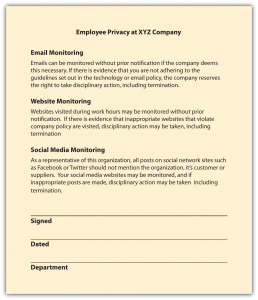Chapter 11: Managing Employee Performance
11.2 Employee Rights
Learning Objectives
By the end of this section, you will be able to:
- Be able to explain employee rights.
- Define unions and explain their relation to the HRM function.
Employee rights is defined as the ability to receive fair treatment from employers. This section will discuss employee rights surrounding job protection, privacy, and unionization.
Constructive dismissal means the employee resigned, but only because the work conditions were so intolerable that he or she had no choice. This usually involves either intimidation, manipulation, or changing the employment contract without sufficient notice. For instance, changing an employee’s title or status, or hours of work, could be considered constructive dismissal. If the courts find that an employee was constructively dismissed, the employer will be liable for a severance package and potentially punitive damages as well.
Privacy Rights
Technology makes it possible to more easily monitor aspects of employees’ jobs, although a policy on this subject should be considered before implementing it. In regard to privacy, a question exists whether an employer should be allowed to monitor an employee’s online activities. This may include work e-mail, websites visited using company property, and also personal activity online.
Digital Footprints, Inc. is a company that specializes in tracking the digital movements of employees and can provide reports to the organization by tracking these footprints. This type of technology might look for patterns, word usage, and other communication patterns between individuals. This monitoring can be useful in determining violations of workplace policies, such as sexual harassment. This type of software and management can be expensive, so before launching it, it’s imperative to address its value in the workplace.
Another privacy concern can include monitoring of employee postings on external websites. Companies such as Social Sentry, under contract, monitor employee postings on sites such as Facebook, Twitter, LinkedIn, and YouTube. [4] Lawyers warn, however, that this type of monitoring should only be done if the employee has consented. [5]
Employees have a right to see their personnel files and the right to see and correct any incorrect information within their files.

CONSTRUCTIVE DISMISSAL means the conditions are so poor that the employee had no choice but to leave the organization
The privacy of employees is an issue that HR must address. It is prudent to develop policies surrounding what type of monitoring may occur within an organization. For example, some organizations monitor e-mail, computer usage, and even postings on social network sites.
[4] Teneros Corporation, “Social Sentry Lets Employers Track Their Workers across the Internet,” accessed March 17, 2011,http://www.readwriteweb.com/archives/social_sentry_track_employees_across_the_web.php.
[5] People Management, “Employers Should Have Monitoring Policy for Social Networks,” accessed March 17, 2011,http://www.peoplemanagement.co.uk/pm/articles/2011/02/employers-should-have-monitoring-policy-for-social-networks.htm.
[6] Rodney Ho, “Chadd Scott Said He Was Fired for Tweets about Delta,” Access Atlanta (blog), accessed March 16, 2011, http://blogs.ajc.com/radio-tv-talk/2011/03/15/680the-fans-chadd-scott-said-he-was-fired-for-tweets-about-delta-airlines/?cxntlid=thbz_hm.
[7] US Equal Employment Opportunity Commission, “The ADA, Your Responsibilities as an Employer,” accessed August 1, 2011, http://www.eeoc.gov/facts/ada17.html.
[9] John Hughes, “You’re Fired Doesn’t Mean Fired to Four of 10 Air Traffic Controllers,”Bloomberg News, July 24, 2011, accessed August 1, 2011,http://www.bloomberg.com/news/2011-07-25/-you-re-fired-doesn-t-mean-fired-to-four-of-10-air-controllers.html.

